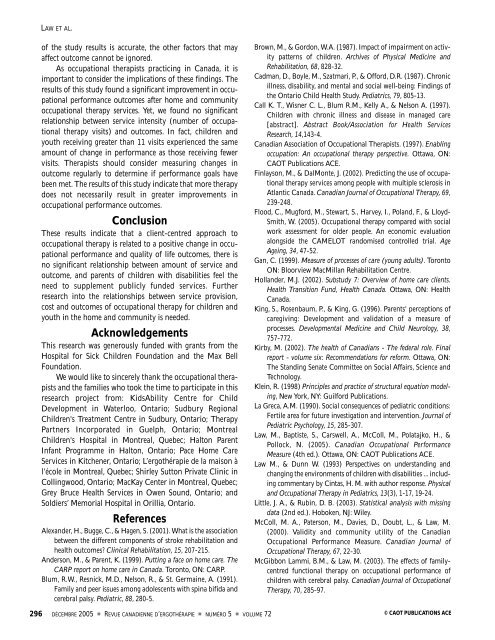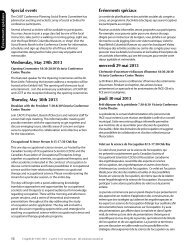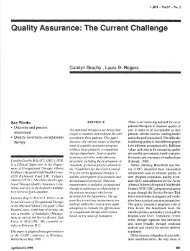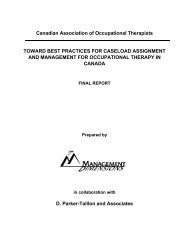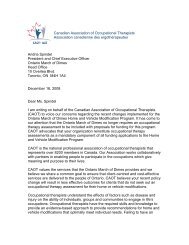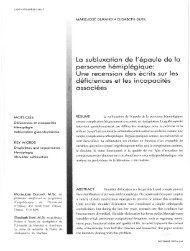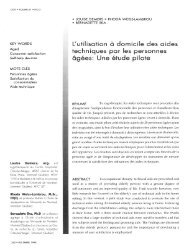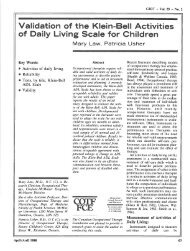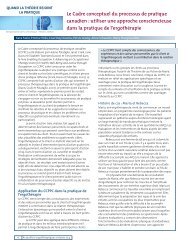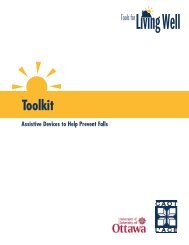Home and community occupational therapy for children and youth: A ...
Home and community occupational therapy for children and youth: A ...
Home and community occupational therapy for children and youth: A ...
You also want an ePaper? Increase the reach of your titles
YUMPU automatically turns print PDFs into web optimized ePapers that Google loves.
LAW ET AL.<br />
of the study results is accurate, the other factors that may<br />
affect outcome cannot be ignored.<br />
As <strong>occupational</strong> therapists practicing in Canada, it is<br />
important to consider the implications of these findings. The<br />
results of this study found a significant improvement in <strong>occupational</strong><br />
per<strong>for</strong>mance outcomes after home <strong>and</strong> <strong>community</strong><br />
<strong>occupational</strong> <strong>therapy</strong> services. Yet, we found no significant<br />
relationship between service intensity (number of <strong>occupational</strong><br />
<strong>therapy</strong> visits) <strong>and</strong> outcomes. In fact, <strong>children</strong> <strong>and</strong><br />
<strong>youth</strong> receiving greater than 11 visits experienced the same<br />
amount of change in per<strong>for</strong>mance as those receiving fewer<br />
visits. Therapists should consider measuring changes in<br />
outcome regularly to determine if per<strong>for</strong>mance goals have<br />
been met. The results of this study indicate that more <strong>therapy</strong><br />
does not necessarily result in greater improvements in<br />
<strong>occupational</strong> per<strong>for</strong>mance outcomes.<br />
Conclusion<br />
These results indicate that a client-centred approach to<br />
<strong>occupational</strong> <strong>therapy</strong> is related to a positive change in <strong>occupational</strong><br />
per<strong>for</strong>mance <strong>and</strong> quality of life outcomes, there is<br />
no significant relationship between amount of service <strong>and</strong><br />
outcome, <strong>and</strong> parents of <strong>children</strong> with disabilities feel the<br />
need to supplement publicly funded services. Further<br />
research into the relationships between service provision,<br />
cost <strong>and</strong> outcomes of <strong>occupational</strong> <strong>therapy</strong> <strong>for</strong> <strong>children</strong> <strong>and</strong><br />
<strong>youth</strong> in the home <strong>and</strong> <strong>community</strong> is needed.<br />
Acknowledgements<br />
This research was generously funded with grants from the<br />
Hospital <strong>for</strong> Sick Children Foundation <strong>and</strong> the Max Bell<br />
Foundation.<br />
We would like to sincerely thank the <strong>occupational</strong> therapists<br />
<strong>and</strong> the families who took the time to participate in this<br />
research project from: KidsAbility Centre <strong>for</strong> Child<br />
Development in Waterloo, Ontario; Sudbury Regional<br />
Children's Treatment Centre in Sudbury, Ontario; Therapy<br />
Partners Incorporated in Guelph, Ontario; Montreal<br />
Children's Hospital in Montreal, Quebec; Halton Parent<br />
Infant Programme in Halton, Ontario; Pace <strong>Home</strong> Care<br />
Services in Kitchener, Ontario; L’ergothérapie de la maison à<br />
l’école in Montreal, Quebec; Shirley Sutton Private Clinic in<br />
Collingwood, Ontario; MacKay Center in Montreal, Quebec;<br />
Grey Bruce Health Services in Owen Sound, Ontario; <strong>and</strong><br />
Soldiers’ Memorial Hospital in Orillia, Ontario.<br />
References<br />
Alex<strong>and</strong>er, H., Bugge, C., & Hagen, S. (2001). What is the association<br />
between the different components of stroke rehabilitation <strong>and</strong><br />
health outcomes? Clinical Rehabilitation, 15, 207-215.<br />
Anderson, M., & Parent, K. (1999). Putting a face on home care. The<br />
CARP report on home care in Canada. Toronto, ON: CARP.<br />
Blum, R.W., Resnick, M.D., Nelson, R., & St. Germaine, A. (1991).<br />
Family <strong>and</strong> peer issues among adolescents with spina bifida <strong>and</strong><br />
cerebral palsy. Pediatric, 88, 280-5.<br />
Brown, M., & Gordon, W.A. (1987). Impact of impairment on activity<br />
patterns of <strong>children</strong>. Archives of Physical Medicine <strong>and</strong><br />
Rehabilitation, 68, 828-32.<br />
Cadman, D., Boyle, M., Szatmari, P., & Of<strong>for</strong>d, D.R. (1987). Chronic<br />
illness, disability, <strong>and</strong> mental <strong>and</strong> social well-being: Findings of<br />
the Ontario Child Health Study. Pediatrics, 79, 805-13.<br />
Call K. T., Wisner C. L., Blum R.M., Kelly A., & Nelson A. (1997).<br />
Children with chronic illness <strong>and</strong> disease in managed care<br />
[abstract]. Abstract Book/Association <strong>for</strong> Health Services<br />
Research, 14,143-4.<br />
Canadian Association of Occupational Therapists. (1997). Enabling<br />
occupation: An <strong>occupational</strong> <strong>therapy</strong> perspective. Ottawa, ON:<br />
CAOT Publications ACE.<br />
Finlayson, M., & DalMonte, J. (2002). Predicting the use of <strong>occupational</strong><br />
<strong>therapy</strong> services among people with multiple sclerosis in<br />
Atlantic Canada. Canadian Journal of Occupational Therapy, 69,<br />
239-248.<br />
Flood, C., Mug<strong>for</strong>d, M., Stewart, S., Harvey, I., Pol<strong>and</strong>, F., & Lloyd-<br />
Smith, W. (2005). Occupational <strong>therapy</strong> compared with social<br />
work assessment <strong>for</strong> older people. An economic evaluation<br />
alongside the CAMELOT r<strong>and</strong>omised controlled trial. Age<br />
Ageing, 34, 47-52.<br />
Gan, C. (1999). Measure of processes of care (young adults). Toronto<br />
ON: Bloorview MacMillan Rehabilitation Centre.<br />
Holl<strong>and</strong>er, M.J. (2002). Substudy 7: Overview of home care clients.<br />
Health Transition Fund, Health Canada. Ottawa, ON: Health<br />
Canada.<br />
King, S., Rosenbaum, P., & King, G. (1996). Parents' perceptions of<br />
caregiving: Development <strong>and</strong> validation of a measure of<br />
processes. Developmental Medicine <strong>and</strong> Child Neurology, 38,<br />
757-772.<br />
Kirby, M. (2002). The health of Canadians - The federal role. Final<br />
report - volume six: Recommendations <strong>for</strong> re<strong>for</strong>m. Ottawa, ON:<br />
The St<strong>and</strong>ing Senate Committee on Social Affairs, Science <strong>and</strong><br />
Technology.<br />
Klein, R. (1998) Principles <strong>and</strong> practice of structural equation modeling,<br />
New York, NY: Guil<strong>for</strong>d Publications.<br />
La Greca, A.M. (1990). Social consequences of pediatric conditions:<br />
Fertile area <strong>for</strong> future investigation <strong>and</strong> intervention. Journal of<br />
Pediatric Psychology, 15, 285-307.<br />
Law, M., Baptiste, S., Carswell, A., McColl, M., Polatajko, H., &<br />
Pollock, N. (2005). Canadian Occupational Per<strong>for</strong>mance<br />
Measure (4th ed.). Ottawa, ON: CAOT Publications ACE.<br />
Law M., & Dunn W. (1993) Perspectives on underst<strong>and</strong>ing <strong>and</strong><br />
changing the environments of <strong>children</strong> with disabilities ... including<br />
commentary by Cintas, H. M. with author response. Physical<br />
<strong>and</strong> Occupational Therapy in Pediatrics, 13(3), 1-17, 19-24.<br />
Little, J. A., & Rubin, D. B. (2003). Statistical analysis with missing<br />
data (2nd ed.). Hoboken, NJ: Wiley.<br />
McColl, M. A., Paterson, M., Davies, D., Doubt, L., & Law, M.<br />
(2000). Validity <strong>and</strong> <strong>community</strong> utility of the Canadian<br />
Occupational Per<strong>for</strong>mance Measure. Canadian Journal of<br />
Occupational Therapy, 67, 22-30.<br />
McGibbon Lammi, B.M., & Law, M. (2003). The effects of familycentred<br />
functional <strong>therapy</strong> on <strong>occupational</strong> per<strong>for</strong>mance of<br />
<strong>children</strong> with cerebral palsy. Canadian Journal of Occupational<br />
Therapy, 70, 285-97.<br />
296 DÉCEMBRE 2005 ■ REVUE CANADIENNE D’ERGOTHÉRAPIE ■ NUMÉRO 5 ■ VOLUME 72 © CAOT PUBLICATIONS ACE


